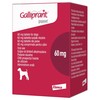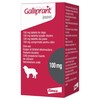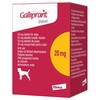Galliprant
Galliprant Flavoured Tablets are a daily non-steroidal anti-inflammatory (NSAID) treatment for dogs to control pain and inflammation associated with osteoarthritis. They have been proven effective in dogs from nine months of age, and work by blocking the key receptor involved in the development of inflammation.
The tablets are speckled brown in colour and have a biconvex oval shape. They have been scored on one side so that they can be divided into equal halves.
Galliprant 60mg Flavoured Tablets for Dogs
£1.56Galliprant 60mg Flavoured Tablets are indicated for the control of pain and inflammation associated with mild to moderate osteoarthritis in dogs. Galliprant is a convenient, once-a-day...[More info]
Galliprant 100mg Flavoured Tablets for Dogs
£2.30Galliprant 100g Flavoured Tablets are indicated for the control of pain and inflammation associated with mild to moderate osteoarthritis in dogs. Designed as once-a-day chewable tablets,...[More info]
Galliprant 20mg Flavoured Tablets for Dogs
£0.79Galliprant 20mg Flavoured Tablets are indicated for the control of pain and inflammation associated with mild to moderate osteoarthritis in dogs. Proven effective, Galliprant is a...[More info]
Contraindications
Do not use in case of hypersensitivity to the active substance or any of the excipients. Do not use in pregnant, lactating or breeding animals, see section below.
Special warnings for each target species
The majority of clinical cases assessed in the clinical field studies suffered from mild to moderate osteoarthritis based on the veterinary assessment. To achieve a substantiated response to treatment, use the veterinary medicinal product only in mild and moderate cases of osteoarthritis.
From the two clinical field studies, the overall success rates based on CBPI (Canine Brief Pain Inventory, as completed by the owner) at 28 days after the start of the treatment, were 51.3% (120/235) for Galliprant and 35.5% (82/231) for the placebo group. This difference in favour of Galliprant was statistically significant (p-value= 0.0008).
A clinical response to treatment is usually seen within 7 days. If no clinical improvement is apparent after 14 days, treatment with Galliprant should be discontinued and different treatment options should be explored in consultation with the veterinarian.
Special precautions for use
Special precautions for use in animals
Grapiprant is a methylbenzenesulfonamide. It is not known whether dogs with a history of hypersensitivity to sulphonamides will exhibit hypersensitivity to grapiprant. If signs of sulphonamide hypersensitivity occur, treatment should be discontinued.
Mild decreases in serum albumin and total protein, most often within the reference range, have been observed in dogs treated with grapiprant but were not associated with any clinically significant observations or events.
Use with caution in dogs suffering from pre-existing liver, cardiovascular or renal dysfunctions or from gastrointestinal disease.
The concurrent use of grapiprant with other anti-inflammatory agents has not been studied and should be avoided.
The safety of the veterinary medicinal product has not been established in dogs under 9 months of age and in dogs weighing less than 3.6 kg.
Special precautions to be taken by the person administering the veterinary medicinal product to animals
Wash hands after handling of the veterinary medicinal product.
In case of accidental ingestion by children, mild and reversible gastrointestinal signs and nausea may be observed. In case of accidental ingestion, seek medical advice immediately and show the package leaflet or the label to the physician.
Adverse reactions (frequency and seriousness)
In clinical studies, the following mild and generally transient adverse reactions have been observed: vomiting, soft-formed faeces, diarrhoea and inappetence. Vomiting was observed very commonly, whereas soft-formed faeces, diarrhoea and inappetence were commonly observed.
In very rare cases, haematemesis or haemorrhagic diarrhoea was reported following clinical use post authorisation in the USA.
The frequency of adverse reactions is defined using the following convention:
- very common (more than 1 in 10 animals treated displaying adverse reactions during the course of one treatment)
- common (more than 1 but less than 10 animals in 100 animals treated)
- uncommon (more than 1 but less than 10 animals in 1,000 animals treated)
- rare (more than 1 but less than 10 animals in 10,000 animals treated)
- very rare (less than 1 animal in 10,000 animals treated, including isolated reports).
Use during pregnancy, lactation or lay
Do not use in pregnant, lactating or breeding animals as the safety of grapiprant has not been established during pregnancy and lactation or in dogs used for breeding.
Interaction with other medicinal products and other forms of interaction
Prior treatment with other anti-inflammatory substances may result in additional or increased severity of adverse effects and accordingly a treatment-free period with such veterinary medicinal products should be observed before the commencement of treatment with this veterinary medicinal product. The treatment-free period should take into account the pharmacokinetic properties of the products used previously.
The concomitant use of protein-bound veterinary medicinal products with grapiprant has not been studied. Commonly used protein-bound veterinary medicinal products include cardiac, anticonvulsant and behavioural medications.
Drug compatibility should be monitored in animals requiring adjunctive therapy.
Amounts to be administered and administration route
For oral use.
Administer this veterinary medicinal product on an empty stomach (e.g. in the morning) and at least one hour before the next meal, once daily at a target dose of 2 mg per kg body weight.
Duration of treatment will depend on the response observed to treatment. As field studies were limited to 28 days, longer-term treatment should be considered carefully, and regular monitoring undertaken by the veterinarian.
Since clinical signs of canine osteoarthritis wax-and-wane, intermittent treatment may be beneficial in some dogs.
Overdose (symptoms, emergency procedures, antidotes), if necessary
In healthy dogs treated with grapiprant for 9 consecutive months, mild and transient soft-formed or mucous faeces, occasionally bloody, and vomiting were observed at daily overdoses of approximately 2.5x and 15x the recommended dose. Grapiprant did not produce any signs of kidney or liver toxicity at daily overdoses of up to 15x the recommended dose.
In case of overdose, symptomatic treatment should be initiated.
Withdrawal period(s)
Not applicable.


